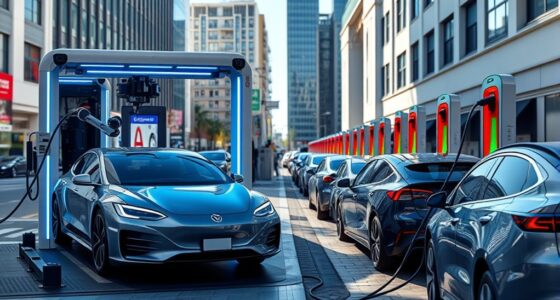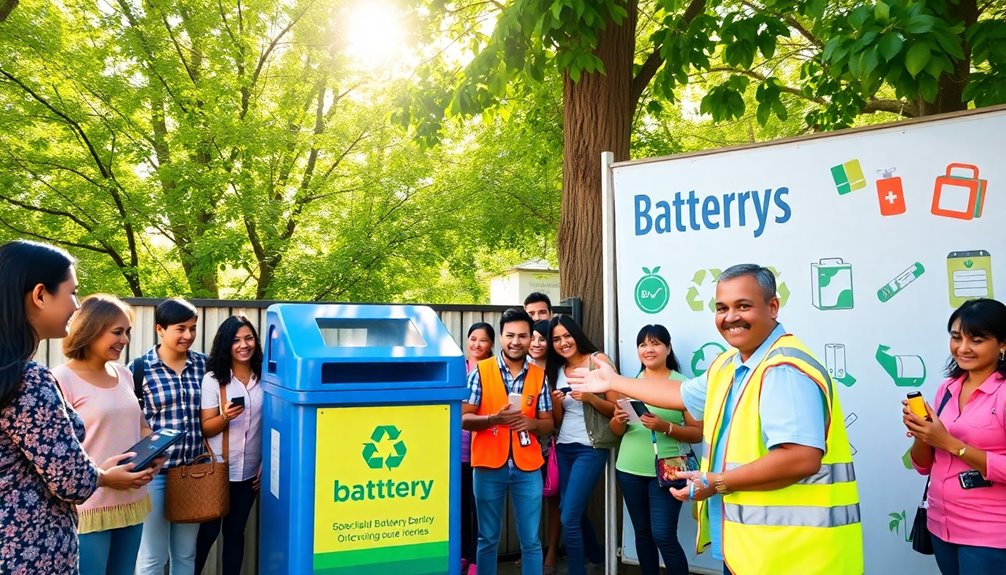The global battery swapping market is rapidly growing thanks to key players investing in advanced battery tech, expanding networks, and pushing industry standards. Innovations like higher energy density, longer-lasting batteries, and faster swapping make EV ownership more convenient. Strategic infrastructure deployment and collaborations help improve accessibility and efficiency. As industry efforts continue toward standardization and automation, the sector’s future looks promising; explore ahead to discover what drives this exciting growth even further.
Key Takeaways
- Major industry players are investing in advanced battery technology and expanding swapping networks for market dominance.
- Standardization efforts across EV brands ensure interoperability and broader consumer adoption of swapping stations.
- Infrastructure deployment in strategic locations reduces wait times, boosting user convenience and market growth.
- Rising consumer demand, government incentives, and sustainability goals accelerate the adoption of battery swapping solutions.
- Technological innovations like solid-state batteries and automation improve efficiency, safety, and operational costs in the market.

The battery swapping market is gaining momentum as a promising solution to address the challenges of electric vehicle (EV) charging, offering faster turnaround times and increased convenience. As you explore this emerging sector, you’ll notice that advancements in battery technology play a crucial role. Innovations such as higher energy density, longer lifespan, and quicker charging capabilities make swapping batteries more viable and appealing. These technological improvements enable swapping stations to deliver batteries that are nearly as efficient as new ones, reducing downtime for EV owners and making the process seamless.
Moreover, the development of robust charging infrastructure is essential to support the growth of battery swapping. Unlike traditional charging stations, swapping facilities require specialized setups that can quickly exchange depleted batteries with fully charged ones. This infrastructure needs to be widespread and strategically located to maximize accessibility and minimize wait times. You’ll see that companies investing in modular, scalable swapping stations are making it easier for EV drivers to adopt this method, especially in urban areas with high vehicle turnover. The increasing deployment of such infrastructure directly correlates with market expansion, as it provides a reliable network for faster vehicle turnaround.
Key players in the industry are actively investing in cutting-edge battery technology and expanding their charging infrastructure networks. These companies are collaborating with vehicle manufacturers to develop standardized battery packs, which is vital for interoperability across different EV brands. Standardization ensures that swapping stations can serve a wide customer base, boosting market adoption. As you observe, the major players are also focusing on automation and smart systems to streamline the swapping process, reducing operational costs and enhancing user experience.
The growth drivers for this market are multifaceted. Rising consumer demand for convenient and quick charging options, coupled with government incentives and supportive policies, fuel the expansion. Additionally, the push toward sustainable transportation and the need to reduce EV charging times further accelerate adoption. You’ll find that technological advancements in battery chemistry, such as solid-state batteries, promise even faster, safer swaps in the future. As these innovations mature, they will likely revolutionize the entire industry, making battery swapping a standard practice.
Frequently Asked Questions
What Are the Major Technological Challenges in Battery Swapping?
You face major technological challenges in battery swapping, mainly guaranteeing consistent battery lifespan and reliable infrastructure development. Developing batteries that maintain performance over many cycles is critical, as is building widespread, standardized swapping stations. These hurdles require advanced battery chemistry and seamless infrastructure integration, so you can assure quick, safe exchanges. Overcoming these issues will boost adoption, making battery swapping a practical alternative to traditional charging methods.
How Does Government Regulation Impact the Battery Swapping Market?
Government regulation can dramatically shape the battery swapping market, acting like a powerful force that accelerates or stalls growth. You’ll find that government policies and environmental regulations set standards for safety, quality, and sustainability, ensuring market integrity. These regulations can encourage innovation, attract investments, and promote eco-friendly practices, ultimately driving adoption. However, overly strict rules might also pose hurdles, making it essential to strike a balance for sustainable industry growth.
What Are Customer Acceptance Levels for Battery Swapping Services?
Customer acceptance levels for battery swapping services are steadily increasing as you prefer quick, convenient solutions for your electric vehicle needs. Market adoption grows when customer preferences shift towards hassle-free alternatives to charging, making swapping stations more appealing. You’re more likely to use these services if they offer reliability, affordability, and widespread availability. As more people adopt battery swapping, the market continues to expand, driven by your demand for efficient, time-saving options.
How Do Battery Swapping Costs Compare to Traditional Charging Methods?
Isn’t it intriguing how the future of energy hinges on cost efficiency? Battery swapping costs generally compare favorably to traditional charging, especially when you consider infrastructure investment. Swapping stations reduce downtime and operational costs, making them more attractive long-term. While initial setup may seem high, the rapid turnaround and lower maintenance expenses make battery swapping a more economical choice over time, ultimately saving you money and accelerating adoption.
What Are Future Innovations Expected in the Battery Swapping Industry?
You can expect future innovations in the battery swapping industry to focus on expanding electric vehicle infrastructure and integrating renewable energy sources. Advances may include faster swap stations, smart grid connections, and automated systems that streamline battery exchange. These innovations aim to make swapping more efficient, sustainable, and accessible, supporting your progression to clean transportation and helping reduce reliance on fossil fuels.
Conclusion
In the rapidly evolving battery swapping market, your opportunities are expanding faster than ever. With key players innovating and growth drivers like sustainability and convenience taking center stage, you’re at the forefront of a revolution that could redefine how the world powers its vehicles. Embrace these changes, because this market’s momentum is so unstoppable, it’s like riding a lightning bolt into the future of clean energy. Stay ahead, because the best is yet to come.









